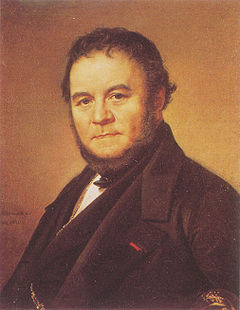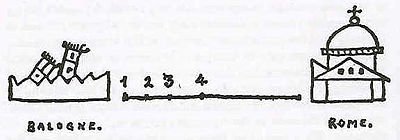- Stendhal
-
Marie-Henri Beyle 
Born 23 January 1783
Grenoble, FranceDied 23 March 1842 (aged 59)
Paris, FranceOccupation Writer Literary movement Realism Marie-Henri Beyle (23 January 1783 – 23 March 1842), better known by his pen name Stendhal, was a 19th-century French writer. Known for his acute analysis of his characters' psychology, he is considered one of the earliest and foremost practitioners of realism in his two novels Le Rouge et le Noir (The Red and the Black, 1830) and La Chartreuse de Parme (The Charterhouse of Parma, 1839).
Contents
Life
Born in Grenoble, Isère, he had an unhappy childhood in what he found to be stifling provincial France, disliking his "unimaginative" father and mourning his mother, who had died when he was young. His closest friend was his younger sister, Pauline, with whom he maintained a steady correspondence throughout the first decade of the 19th century.
The military and theatrical worlds of the First French Empire were a revelation to Beyle. He was named an auditor with the Conseil d'État on 3 August 1810, and thereafter took part in the French administration and in the Napoleonic wars in Italy. He travelled extensively in Germany and was part of Napoleon's army in the 1812 invasion of Russia.[1]
After the 1814 Treaty of Fontainebleau, he left for Italy, where he settled in Milan. He formed a particular attachment to Italy, where he spent much of the remainder of his career, serving as French consul at Trieste and Civitavecchia. His novel The Charterhouse of Parma, written in 52 days, is set in Italy, which he considered a more sincere and passionate country than Restoration France. An aside in that novel, referring to a character who contemplates suicide after being jilted, speaks volumes about his attitude towards his home country: "To make this course of action clear to my French readers, I must explain that in Italy, a country very far away from us, people are still driven to despair by love."
French literature By category French literary history French writers Chronological list
Writers by category
Novelists · Playwrights
Poets · Essayists
Short story writersPortals France · Literature Beyle used the pseudonym "Stendhal" (and over 100 others), and scholars in general believe he borrowed this nom de plume from the German city of Stendal in homage to Johann Joachim Winckelmann.
Stendhal was a dandy and wit about town in Paris, as well as an inveterate womaniser who was obsessed with his sexual conquests. His genuine empathy towards women is evident in his books; Simone de Beauvoir spoke highly of him in The Second Sex. He seems to have preferred desire to consummation. One of his early works is On Love, a rational analysis of romantic passion that was based on his unrequited love for Mathilde, Countess Dembowska, whom he met while living at Milan. This fusion of, and tension between, clear-headed analysis and romantic feeling is typical of Stendhal's great novels; he could be considered a Romantic realist.
Stendhal suffered miserable physical disabilities in his final years as he continued to produce some of his best work. As he noted in his journal, he was taking iodide of potassium and quicksilver to treat his syphilis, resulting in swollen armpits, difficulty swallowing, pains in his shrunken testicles, sleeplessness, giddiness, roaring in the ears, racing pulse and tremors so bad he could scarcely hold a fork or a pen. Indeed, he dictated Charterhouse in this pitiable state. Modern medicine has shown that his health problems were more attributable to his treatment than to his syphilis.
Stendhal died on 22 March 1842, a few hours after collapsing with a seizure on the streets of Paris. He is interred in the Cimetière de Montmartre.
Works
Contemporary readers did not fully appreciate Stendhal's realistic style during the Romantic period in which he lived; he was not fully appreciated until the beginning of the 20th century. He dedicated his writing to "the Happy Few." This is often interpreted as a dedication to the few who could understand his writing, or as a sardonic reference to the happy few who are born into prosperity (the latter interpretation is supported by the likely source of the quotation, Canto 11 of Byron's Don Juan, a frequent reference in the novel, which refers to "the thousand happy few" who enjoy high society), or as a reference to those who lived without fear or hatred. It may also refer, given Stendhal's experience of the Napoleonic wars, to the "we few, we happy few, we band of brothers" line of Shakespeare's Henry V. He did have influence as a literary critic. In Racine and Shakespeare he championed the Romantic aesthetic, comparing the rules and strictures of Racine's classicism unfavorably to the freer verse and settings of Shakespeare, and supporting the writing of plays in prose.
Today, Stendhal's works attract attention for their irony and psychological and historical dimensions. Stendhal was an avid fan of music, particularly the works of the composers Cimarosa, Mozart and Rossini. He wrote a biography about Rossini, Vie de Rossini (1824), now more valued for its wide-ranging musical criticism than for its historical content.
In his works, Stendhal "plagiarized", reprised, appropriated, excerpts from Giuseppe Carpani, Théophile Frédéric Winckler, Sismondi and others.[2][3][4][5]
Novels
- Armance (1827)
- Le Rouge et le Noir (variously translated as Scarlet and Black, Red and Black, The Red and the Black, 1830)
- Lucien Leuwen (1835, unfinished, published 1894)
- La Chartreuse de Parme (1839) (The Charterhouse of Parma)
- Lamiel (1839–1842, unfinished, published 1889)
Novellas
- The Pink and the Green (1837, unfinished)
- Mina de Vanghel (1830, later published in La Revue des Deux Mondes)
- Vanina Vanini (1829)
- Italian Chroniques, 1837–1839
- Vittoria Accoramboni
- The Cenci (Les Cenci, 1837)
- The Duchess of Palliano (La Duchesse de Palliano)
- The Abbess of Castro (L'Abbesse de Castro, 1832)
Biography
- A Life of Napoleon (1817–1818, published 1929)
- A Life of Rossini (1824)
Autobiography
Stendhal's brief memoir, Souvenirs d'Égotisme (Memoirs of an Egotist) was published posthumously in 1892. Also published was a more extended autobiographical work, thinly disguised as the Life of Henry Brulard.
- The Life of Henry Brulard (1835–1836, published 1890)
- Souvenirs d'Égotisme (Memoirs of an Egotist, published in 1892)
- Journal (1801–1817) (The Private Diaries of Stendhal)
Non-fiction
- Racine et Shakespéare (1823–1835) (Racine and Shakespeare)
- De L'Amour (1822) (On Love)
His other works include short stories, journalism, travel books (among them Rome, Naples et Florence and Promenades dans Rome), a famous collection of essays on Italian painting, and biographies of several prominent figures of his time, including Napoleon, Haydn, Mozart, Rossini and Metastasio.
Crystallization
In Stendhal's 1822 classic On Love he describes or compares the “birth of love”, in which the love object is 'crystallized' in the mind, as being a process similar or analogous to a trip to Rome. In the analogy, the city of Bologna represents indifference and Rome represents perfect love:
When we are in Bologna, we are entirely indifferent; we are not concerned to admire in any particular way the person with whom we shall perhaps one day be madly in love; even less is our imagination inclined to overrate their worth. In a word, in Bologna “crystallization” has not yet begun. When the journey begins, love departs. One leaves Bologna, climbs the Apennines, and takes the road to Rome. The departure, according to Stendhal, has nothing to do with one’s will; it is an instinctive moment. This transformative process actuates in terms of four steps along a journey:
- Admiration – one marvels at the qualities of the loved one.
- Acknowledgement – one acknowledges the pleasantness of having gained the loved one's interest.
- Hope – one envisions gaining the love of the loved one.
- Delight – one delights in overrating the beauty and merit of the person whose love one hopes to win.
This journey or crystallization process (shown above) was detailed by Stendhal on the back of a playing card while speaking to Madame Gherardi, during his trip to the Salzburg salt mine.
Stendhal syndrome
In 1817 Stendhal reportedly was overcome by the cultural richness of Florence he encountered when he first visited the Tuscan city. As he described in his book Naples and Florence: A Journey from Milan to Reggio:
As I emerged from the porch of Santa Croce, I was seized with a fierce palpitation of the heart (that same symptom which, in Berlin, is referred to as an attack of the nerves); the well-spring of life was dried up within me, and I walked in constant fear of falling to the ground.
The condition was diagnosed and named in 1979 by Italian psychiatrist Dr. Graziella Magherini, who had noticed similar psychosomatic conditions (racing heart beat, nausea and dizziness) amongst first-time visitors to the city.
In homage to Stendhal, Trenitalia named their overnight train service from Paris to Venice the Stendhal Express.
See also
- Mononymous persons
Notes
- ^ Stendhal (2002). The Red and the Black. New York: Penguin Classics.
- ^ Randall (2001) p.199 quote:
If the plagiarisms of Stendhal are legion, many are virtually translations: that is, cross-border plagiarism. Maurevert reports that Goethe, commenting enthusiastically on Stendhal's Rome, Naples et Florence, notes in a letter to a friend: 'he knows very well how to use what one reports to him, and, above all, he knows well how to appropriate foreign works. He translates passages from my Italian Journey and claims to have heard the anecdote recounted by a marchesina.'
- ^ Victor Del Litto in Stendhal (1986) p.500, quote (translation by Randall 2001 p.199):
used the texts of Carpani, Winckler, Sismondi et 'tutti quanti', as an ensemble of materials that he fashioned in his own way. In other words, by isolating his personal contribution, one arrives at the conclusion that the work, far from being a cento, is highly structured such that even the borrowed parts finally melt into a whole a l'allure bien stendhalienne
- ^ Hazard (1921)
- ^ Catherine Dousteyssier-Khoze, Floriane Place-Verghnes (2006) Poétiques de la parodie et du pastiche de 1850 à nos jours p.34
References
- Paul Hazard (1921) Les plagiats de Stendhal
- Randall, Marilyn (2001) Pragmatic plagiarism: authorship, profit, and power
- George Maurevert (1922) Le livre des plagiats
- Stendhal and Del Litto, Victor and Abravanel, Ernest (1986) Oeuvres complètes: Vies de Haydn, de Mozart et de Métastase, volume 41
Further reading
- Ann Jefferson, Reading Realism in Stendhal (Cambridge Studies in French), Cambridge, UK: Cambridge University Press, 1988.
- Joanna Richardson, Stendahl: A Biography, Gollancz, 1974. ISBN 0575018704
External links
- English site on Stendhal
- Works by Stendhal in English translation at The University of Adelaide Library
- Works by Stendhal at Project Gutenberg
- Works by and about Stendhal at Internet Archive
- Works by or about Stendhal in libraries (WorldCat catalog)
- Stendhal's works: text, concordances and frequency list
- (French) Audio Book (mp3) of The Red and the Black incipit
- (French) French site on Stendhal
- Centro Stendhaliano di Milano Digital version of Stendhal's shoulder-notes on his own books.
Categories:- 1783 births
- 1842 deaths
- People from Grenoble
- 19th-century French writers
- Council of State (France)
- French novelists
- French essayists
- French biographers
- French short story writers
- Travel writers
- French travel writers
- Romanticism
- Burials at Montmartre Cemetery
- Pseudonymous writers
Wikimedia Foundation. 2010.


